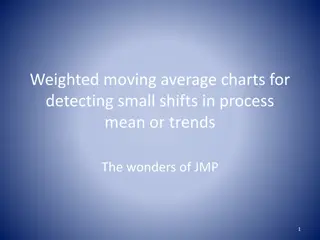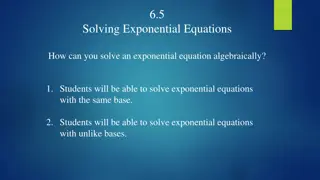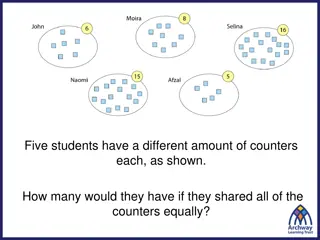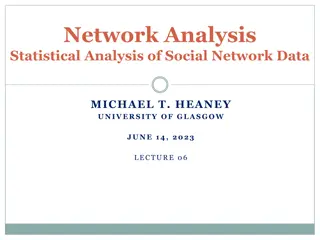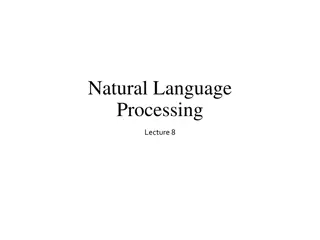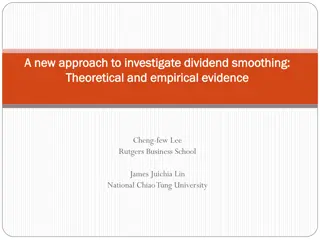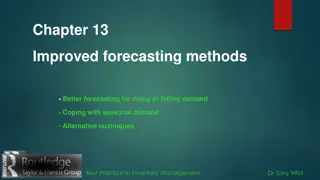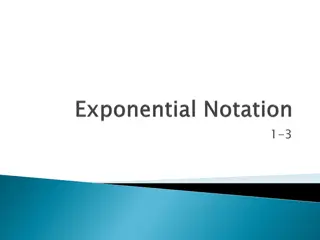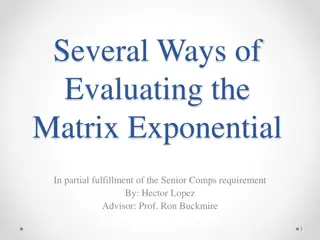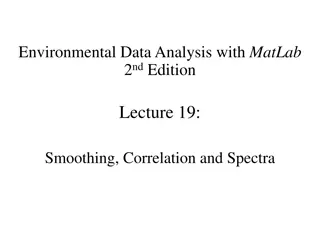Understanding Moving Averages and Exponential Smoothing Methods
Forecasting methods like moving averages and exponential smoothing are essential for analyzing time series data. Averaging methods involve equally weighted observations, while exponential smoothing methods assign unequal weights that decay exponentially. Both methods can be useful for forecasting in different scenarios, depending on the characteristics of the data. Single and moving averages, as well as exponential smoothing techniques like SES, Holt's method, and Holt-Winters method, play crucial roles in generating forecasts based on historical data trends. Understanding these methods is key to making informed predictions in data analysis and forecasting projects.
Download Presentation

Please find below an Image/Link to download the presentation.
The content on the website is provided AS IS for your information and personal use only. It may not be sold, licensed, or shared on other websites without obtaining consent from the author. Download presentation by click this link. If you encounter any issues during the download, it is possible that the publisher has removed the file from their server.
E N D
Presentation Transcript
MOVING AVERAGES AND EXPONENTIAL SMOOTHING
Introduction Forecasting methods: Averaging methods. Equally weighted observations Exponential Smoothing methods. Unequal set of weights to past data, where the weights decay exponentially from the most recent to the most distant data points. These parameters (with values between 0 and 1) will determine the unequal weights to be applied to past data.
Introduction Averaging methods If a time series is generated by a constant process subject to random error, then mean is a useful statistic and can be used as a forecast for the next period. Averaging methods are suitable for stationary time series data where the series is in equilibrium around a constant value ( the underlying mean) with a constant variance over time.
Introduction Exponential smoothing methods The simplest exponential smoothing method is the single smoothing (SES) method where only one parameter needs to be estimated Holt s method makes use of two different parameters and allows forecasting for series with trend. Holt-Winters method involves three smoothing parameters to smooth the data, the trend and the seasonal index.
Averaging Methods The Mean Uses the average of all the historical data as the forecast 1 t = i += 1 F y t i t 1 When new data becomes available , the forecast for time t+2 is the new mean including the previously observed data plus this new observation. + 1 1 t = i = F y + 2 t i + 1 t 1 This method is appropriate when there is no noticeable trend or seasonality.
Averaging Methods The moving average for time period t is the mean of the k most recent observations. The constant number k is specified at the outset. The smaller the number k, the more weight is given to recent periods. The greater the number k, the less weight is given to more recent periods.
Single Moving Averages A large k is desirable when there are wide, infrequent fluctuations in the series. A small k is most desirable when there are sudden shifts in the level of series. For quarterly data, a four-quarter moving average, MA(4), eliminates or averages out seasonal effects.
Single Moving Averages For monthly data, a 12-month moving average, MA(12), eliminate or averages out seasonal effect. Equal weights are assigned to each observation used in the average. Each new data point is included in the average as it becomes available, and the oldest data point is discarded.
Single Moving Averages A moving average of order k, MA(k) is the value of k consecutive observations. (y F y + + = = + + + + y y y ) t 1 t k 1 + t t 2 k t 1 t 1 t 1 k = F y t 1 + i i t k 1 = + k is the number of terms in the moving average. The moving average model does not handle trend or seasonality very well although it can do better than the total mean.
Example: Weekly Department Store Sales Period (t) 1 2 3 4 5 6 7 8 9 10 11 12 13 14 15 16 17 18 19 20 21 22 23 24 25 Sales (y) 5.3 4.4 5.4 5.8 5.6 4.8 5.6 5.6 5.4 6.5 5.1 5.8 5 6.2 5.6 6.7 5.2 5.5 5.8 5.1 5.8 6.7 5.2 6 5.8 The weekly sales figures (in millions of dollars) presented in the following table are used by a major department store to determine the need for temporary sales personnel.
Example: Weekly Department Store Sales Weekly Sales 8 7 6 5 Sales 4 Sales (y) 3 2 1 0 0 5 10 15 20 25 30 Weeks
Example: Weekly Department Store Sales Use a three-week moving average (k=3) for the department store sales to forecast for the week 24 and 26. (y y y ) 5.2 6.7 5.8 y 3 + + + + = = = 5.9 23 22 21 24 3 The forecast error is = 6 5.9 .1 = = y e y 24 24 24
Example: Weekly Department Store Sales The forecast for the week 26 is + + + + y y y 5.8 6 5.2 3 = = = y 5.7 25 24 3 23 26
Example: Weekly Department Store Sales Period (t) 1 2 3 4 5 6 7 8 9 10 11 12 13 14 15 16 17 18 19 20 21 22 23 24 25 Sales (y) forecast 5.3 4.4 5.4 5.8 5.6 4.8 5.6 5.6 5.4 6.5 5.1 5.8 5 6.2 5.6 6.7 5.2 5.5 5.8 5.1 5.8 6.7 5.2 6 5.8 RMSE = 0.63 5.033333 Weekly Sales Forecasts 5.2 5.6 5.4 8 5.333333 5.333333 5.533333 5.833333 5.666667 7 6 5 5.8 5.3 Sales (y) Sales 4 5.666667 forecast 5.6 3 6.166667 5.833333 2 5.8 5.5 5.466667 5.566667 5.866667 1 0 5.9 0 5 10 15 20 25 30 Weeks 5.966667 5.666667
Double Moving Average Given the data (1) (2) (3) (4) Error (2)-(3) (5) (6) (7) Error (3)- (5) Forecasting (3)+(6)+trend Period Data MA(3) MA(3x3) 1 2 3 4 5 6 7 8 9 10 11 2 4 6 8 10 12 14 16 18 20 4 6 8 10 12 14 16 18 2 2 2 2 2 2 2 2 6 8 10 12 14 16 2 2 2 2 2 2 12 14 16 18 20 22
Double Moving Average Forecasting procedure: Using single moving average at time t (St ) Fitting: the difference between single moving average and double moving average at time t (St St ) Fitting: trend from t period to t+1 period (or to t+m period if we want to forecast m period)
Double Moving Average Generally, the procedure of double moving average given as bellow: + + + ... X + X X X = ' t t 1 t k 1 + S t t 2 k + + + ... S + S S S = '' t t 1 t k 1 + S t t 2 k ( ) = + = ' t ' t '' t ' t '' t a S S S 2S S t 2 + ( ) = ' t '' t b S S t k 1 a = t m F + b m t t




